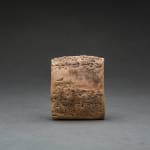Sumerian Cuneiform Tablet, 2026 BCE
1.85 x 2.2
AM.0209
Sumerian cuneiform is one of the earliest known forms of written expression. First appearing in the 4th millennium BC in what is now Iraq, it was dubbed cuneiform (‘wedge-shaped’) because...
Sumerian cuneiform is one of the earliest known forms of written expression. First appearing in the 4th millennium BC in what is now Iraq, it was dubbed cuneiform (‘wedge-shaped’) because of the distinctive wedge form of the letters, created by pressing a reed stylus into wet clay. Early Sumerian writings were essentially pictograms, which became simplified in the early and mid 3rd millennium BC to a series of strokes, along with a commensurate reduction in the number of discrete signs used (from c.1500 to 600). The script system had a very long life and was used by the Sumerians as well as numerous later groups – notably the Assyrians, Elamites, Akkadians and Hittites – for around three thousand years. Certain signs and phonetic standards live on in modern languages of the Middle and Far East, but the writing system is essentially extinct. It was therefore cause for great excitement when the ‘code’ of ancient cuneiform was cracked by a group of English, French and German Assyriologists and philologists in the mid 19th century AD. This opened up a vital source of information about these ancient groups that could not have been obtained in any other way.
Cuneiform was used on monuments dedicated to heroic – and usually royal – individuals, but perhaps its most important function was that of record keeping. The palace-based society at Ur and other large urban centres was accompanied by a remarkably complex and multifaceted bureaucracy, which was run by professional administrators and a priestly class, all of whom were answerable to central court control. Most of what we know about the way the culture was run and administered comes from cuneiform tablets, which record the everyday running of the temple and palace complexes in minute detail, as in the present case. The Barakat Gallery has secured the services of Professor Lambert (University of Birmingham), a renowned expert in the decipherment and translation of cuneiform, to examine and process the information on these tablets. The following is a transcription of his analysis of this tablet:
‘An administrative document from the period of the Third Dynasty of Ur, dated to the third year of Ibbi-Sin, last king of the dynasty, c. 2026 B.C. It is a note recording that irrigated land was assigned to serfs for one month for them to work on, with some rare and obscure lines following, ending with a statement that the clerk in charge had taken an oath in the king’s name. This is extremely unusual, plainly implying the risk that the official was not honest! It is then all the more unfortunate that the preceding wording is so rare and obscure.
Translation:
30 serfs, 18 iku (of irrigated land) each, day 1 for 30 days. The area of land: 480 iku, clerk: Shulgi-sisa. While the barley….barley rations of Ili-meda. Shulgi-sisa took an oath by the king. Year: Ibbi-Sin, king of Ur destroyed Simurrum.
Seal inscription: Ibbi-Sin, mighty king, king of Ur….-Ninisina, rider, your servant.
An iku was a measure of an area, about 3530 square metres. Serfs were tied to their jobs, but were free in hours off work. The total of area given does not seem right to us, but there may be an explanation not now clear.’
Cuneiform was used on monuments dedicated to heroic – and usually royal – individuals, but perhaps its most important function was that of record keeping. The palace-based society at Ur and other large urban centres was accompanied by a remarkably complex and multifaceted bureaucracy, which was run by professional administrators and a priestly class, all of whom were answerable to central court control. Most of what we know about the way the culture was run and administered comes from cuneiform tablets, which record the everyday running of the temple and palace complexes in minute detail, as in the present case. The Barakat Gallery has secured the services of Professor Lambert (University of Birmingham), a renowned expert in the decipherment and translation of cuneiform, to examine and process the information on these tablets. The following is a transcription of his analysis of this tablet:
‘An administrative document from the period of the Third Dynasty of Ur, dated to the third year of Ibbi-Sin, last king of the dynasty, c. 2026 B.C. It is a note recording that irrigated land was assigned to serfs for one month for them to work on, with some rare and obscure lines following, ending with a statement that the clerk in charge had taken an oath in the king’s name. This is extremely unusual, plainly implying the risk that the official was not honest! It is then all the more unfortunate that the preceding wording is so rare and obscure.
Translation:
30 serfs, 18 iku (of irrigated land) each, day 1 for 30 days. The area of land: 480 iku, clerk: Shulgi-sisa. While the barley….barley rations of Ili-meda. Shulgi-sisa took an oath by the king. Year: Ibbi-Sin, king of Ur destroyed Simurrum.
Seal inscription: Ibbi-Sin, mighty king, king of Ur….-Ninisina, rider, your servant.
An iku was a measure of an area, about 3530 square metres. Serfs were tied to their jobs, but were free in hours off work. The total of area given does not seem right to us, but there may be an explanation not now clear.’



